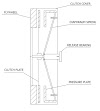Diaphragm Clutch:-
In this type of clutch , the clamping pressure is provided by means of a diaphragm instead of coil pressure spring.
Construction Of Diaphragm Clutch:-
- I t consist of pressure plate , diaphragm spring ,fulcrum ring, cover bolted to flywheel ,release bearing and fork.
- The diaphragm is conical steel disk, with its outer periphery located in pressure plate but pivoted to cover by fulcrum rings and locating studs.
- There are slots starting from center of diaphragm to form a number of release fingers . This release bearing applies pressure at the center of diaphragm.
Working Of Diaphragm Clutch:-
- When clutch is in engaged position. The conical diaphragm has been flattened in order to exert thrust on the pressure plate and friction facings.
- When the clutch pedal is pressed, the release bearing exerts pressure at center of the diaphragm spring.
- The outer edge of diaphragm moves away from the flywheel, disengaging the pressure plate from the clutch plate.
- The pedal efforts required to disengage the clutch is little compared to conventional (coil spring type) clutch.
- This is because of fact that little force required to press the diaphragm spring when it gets curved.
- When clutch is in engaged position. The conical diaphragm has been flattened in order to exert thrust on the pressure plate and friction facings.
- When the clutch pedal is pressed, the release bearing exerts pressure at center of the diaphragm spring.
- The outer edge of diaphragm moves away from the flywheel, disengaging the pressure plate from the clutch plate.
- The pedal efforts required to disengage the clutch is little compared to conventional (coil spring type) clutch.
- This is because of fact that little force required to press the diaphragm spring when it gets curved.
Advantages of Diaphragm Clutch:-
- Diaphragm clutch required less efforts to disengage the clutch
- Diaphragm clutch is silent in operation because of less moving parts.
- It does not have release lever, the slots emanating from the diaphragm center act as a series of levers.
- It is compact in size and requires only a small sized housing.
- Maintenance cost is low because of less moving parts.
Applications of Diaphragm Clutch:-
- Light commercial vehicles
- All types of cars





2 Comments
This tutorial is very important for me and thank you so much for sir
ReplyDeleteFor enhanced safety in your projects, choose our woven barricade tape. Its vibrant colors and sturdy design provide excellent visibility, making it perfect for controlling access to restricted areas. We're here to support your safety needs!
ReplyDelete